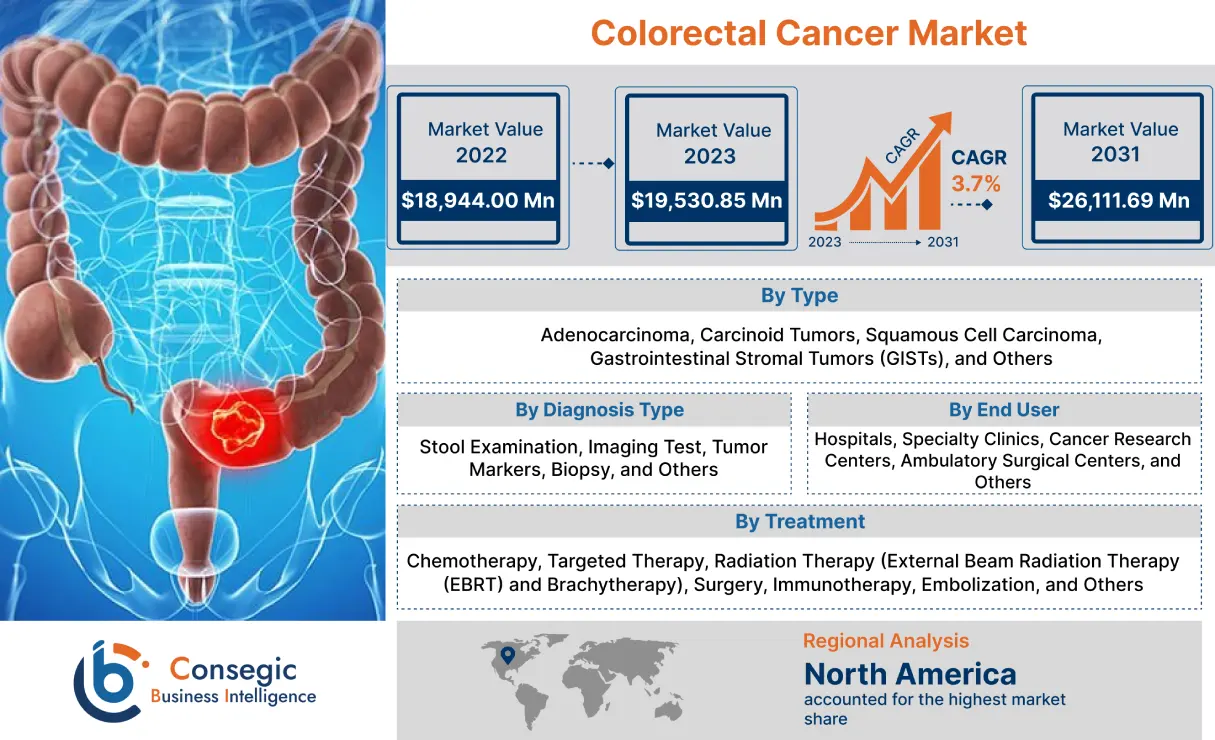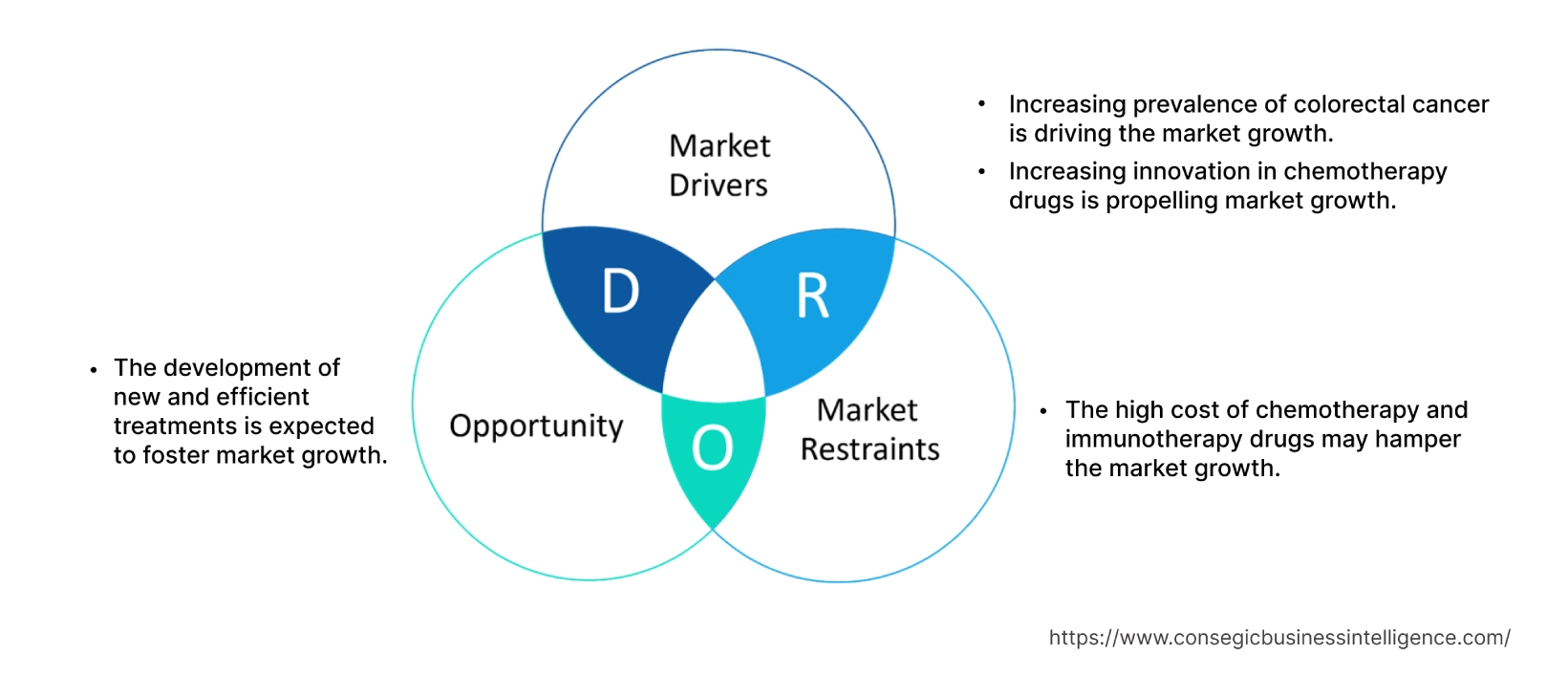Colorectal Cancer Market Size :
Consegic Business Intelligence analyzes that the Global Colorectal Cancer Market size is growing with a CAGR of 3.7% during the forecast period (2023-2031), and the market is projected to be valued at USD 26,111.69 Million by 2031 and USD 19,530.85 Million in 2023 from USD 18,944.00 Million in 2022.
Colorectal Cancer Market Scope & Overview:
Colorectal cancer (CRC) is a type of cancer that starts in the colon or rectum. The colon is the large intestine, and the rectum is the passageway that connects the colon to the anus. It usually develops from precancerous polyps, which are abnormal growths on the inner lining of the colon or rectum. Over time, some polyps can turn into cancer.
The symptoms of the cancer can vary depending on the stage of the cancer and where it is located. Some common symptoms include changes in bowel habits, such as diarrhea, constipation, or narrowing of the stool, severe abdominal pains, rectal bleeding with bright red blood, and others.
Colorectal Cancer Market Insights :
Key Drivers :
Increasing prevalence of colorectal cancer
CRC is a disease in which cells in the colon or rectum grow out of control. There is a significant increase in the the cancer rate, contributing to the growing for treatment options. For instance, according to a study by the World Health Organization (WHO), in 2020 more than 1.9 million new cases of this cancer and more than 930,000 deaths due to it have occurred worldwide. Majority of the this cancer cases arise due to obesity, lack of exercise, and poor diet. Also, the increasing use of antibiotics is also a prominent factor proliferating the market growth. Furthermore, screening tests for this cancer are leading to a rise in the number of detected cases. For instance, according to the National Cancer Institute (U.S.) in 2020, 35% of CRC were detected at an early stage and had a 5-year survival rate of 90.9%. Analysis of market trends concludes that the increase in detected cases of this cancer has augmented the demand for treatments and therapeutics.
Increasing innovation in chemotherapy drugs
Increasing technological advances in chemotherapy and immunotherapy drugs are constantly improving the survival rate for CRC and encouraging more patients to seek early diagnosis and treatment. According to a report by the American Cancer Society in 2021, the mortality rates reduced by 57% between 1970 and 2020, reflecting both earlier diagnosis through screening and advances in surgical techniques and novel systemic therapies. Moreover, improving imaging technology and endoscopic surgery have resulted in the early detection and treatment of this cancer. Analysis of market trends concludes that the increasing innovation in chemotherapy drugs has surged the colorectal cancer market demand.
Key Restraints :
The high cost of chemotherapy and immunotherapy drugss
Chemotherapy and immunotherapy drugs are the primary treatment for cancers presently. These drugs are usually expensive owing to the complex development process, extensive clinical trials, and monopoly of pharmaceutical companies developing drugs. For instance, according to the report published by the Centers for Disease Control and Prevention, approximately USD 183 billion was spent in the U.S. on cancer-related health care in 2015, and this amount is projected to grow to USD 246 billion by 2030, an increase of 34%. Due to insufficient insurance coverage, most households are unable to pay the high costs of cancer drugs. For instance, according to a study by the National Institute of Health in 2021, 95% of CRC patients faced issues financing their treatments despite having insurance. Analysis of market trends concludes that the high cost of this cancer treatments may restrict the growth of the colorectal cancer market.
Future Opportunities :
The development of new and efficient treatments
Therapies and treatments for colorectal cancer are improving with advancements in drugs, treatment plans, minimally invasive surgeries, combinations of drugs, immunotherapy, and others. With constant research for this cancer treatments, the demand for cancer therapeutics is growing significantly. Further, the rise in research and development investment for new drugs and therapies is likely to create lucrative opportunities for the key players operating in the colorectal cancer market.
In addition to this, according to the report by the World Health Organization (WHO), the burden of this cancer will increase to 3.2 million new cases per year, by the year 2040. Analysis of market trends concludes that the rise in incidence rates of this cancer is emerging as one of many colorectal cancer market opportunities that will drive market expansion over the forecast period.
Colorectal Cancer Market Report Insights :
| Report Attributes | Report Details |
| Study Timeline | 2017-2031 |
| Market Size in 2031 | USD 26,111.69 Million |
| CAGR (2023-2031) | 3.7% |
| By Type | Adenocarcinoma, Carcinoid Tumors, Squamous Cell Carcinoma, Gastrointestinal Stromal Tumors (GISTs), and Others |
| By Diagnosis Type | Stool Examination, Imaging Test, Tumor Markers, Biopsy, and Others |
| By Treatment | Chemotherapy, Targeted Therapy, Radiation Therapy (External Beam Radiation Therapy (EBRT) and Brachytherapy), Surgery, Immunotherapy, Embolization, and Others |
| By End User | Hospitals, Specialty Clinics, Cancer Research Centers, Ambulatory Surgical Centers, and Others |
| By Region | North America, Europe, Asia-Pacific, Latin America, and Middle East & Africa |
| Key Players | Pfizer, Sanofi, Genentech USA, Inc., Merck & Co., Inc, Eli Lilly and Company, TAIHO ONCOLOGY, INC., Epigenomics Inc., Bayer, Bristol-Myers Squibb Company, and GSK |
Colorectal Cancer Market Segmental Analysis :
By Type :
The type segment is categorized into adenocarcinoma, carcinoid tumors, squamous cell carcinoma, gastrointestinal stromal tumors (GISTs), and others. In 2022, the adenocarcinoma segment accounted for the highest colorectal cancer market share. The rapid increase in the number of smokers across the globe is one of the key factors contributing to the segment growth. For instance, according to a study conducted by the Centers of Disease Control and Prevention in 2021, 11.5% of U.S. adults, an estimated 28.3 million people smoke cigarettes. Hence, a large number of smokers are at high risk for developing this cancer. Examination of market trends concludes that the demand for cancer therapeutics is increasing, due to the increasing prevalence of colorectal adenocarcinoma.
However, the carcinoid tumors segment is anticipated to grow at the fastest CAGR during the forecast period. The increase in GI tract syndromes and smoking are significant factors that cause this type of cancer. Moreover, patients suffering from thyroid conditions are at a higher risk for developing this type of cancer. According to a study by the American Thyroid Association in 2021, more than 12% of the U.S. population will develop a thyroid condition during their lifetime. Analysis of colorectal cancer market trends concludes that the rising number of patients with thyroid conditions is another factor contributing to the segment growth over the forecast period.
By Diagnosis Type :
The diagnosis type segment is categorized into stool examination, imaging test, tumor markers, biopsy, and others. In 2022, the biopsy segment accounted for the highest market share and is also expected to grow at the fastest CAGR in the overall colorectal cancer market. Endoscopic biopsy is done during a colonoscopy, wherein a small portion of the tumor tissues is removed and sent for examination to detect the presence of cancer. Additionally, biopsy is the most reliable diagnosis method for cancer due to its high accuracy and ability to diagnose the stage of cancer progression. Furthermore, a biopsy is a minimally invasive and fast procedure making it the preferred diagnosis technique among many healthcare providers. Examination of market trends concludes that the growing demand for fast and painless diagnosis is a significant factor that will aid in surging the colorectal cancer market growth.
By Treatment :
The treatment segment is categorized into chemotherapy, targeted therapy, radiation therapy, surgery, immunotherapy, embolization, and others. In 2022, the chemotherapy segment accounted for the highest market share in the colorectal cancer market. Chemotherapy is the primary treatment for all types of cancer, chemotherapy drugs are injected into the patients, and they work by killing all the fast-growing cells in the area. Furthermore, according to a study by the American Cancer Society, approximately 65% of patients with stage 3 and 4 cancer undergo some form of chemotherapy in their treatment.
However, the immunotherapy segment is expected to grow at the fastest CAGR in the following years. Immunotherapy involves training the immune system to better detect and eliminate cancer cells without injecting harmful chemicals into the body. Moreover, this treatment procedure avoids the damage to healthy cells and tissues, that is likely to be caused by chemotherapy. Hence, the patients receiving immunotherapy are likely to show fewer side effects. As a result, the benefits mentioned above are anticipated to surge the demand for immunotherapy, in turn driving the segment growth over the projected period.
By End-User :
The end user segment is categorized into hospitals, specialty clinics, cancer research centers, ambulatory surgical centers, and others. In 2022, the hospitals industry accounted for the highest market share of 45.50% and is also expected to grow at the fastest CAGR in the overall colorectal cancer market. Diagnosis of cancer requires advanced testing and detection techniques, as well as extensive care for the patients. Hospitals have the necessary infrastructure needed to provide such extensive care. Furthermore, developing a treatment plan for CRC requires the presence of medical professionals from different specialties. Hospitals have a vast network of medical professionals who are available to patients at their convenience. Thus, owing to the advanced infrastructure and convenience offered by hospital industry, the aforementioned factors will sure segment proliferation.
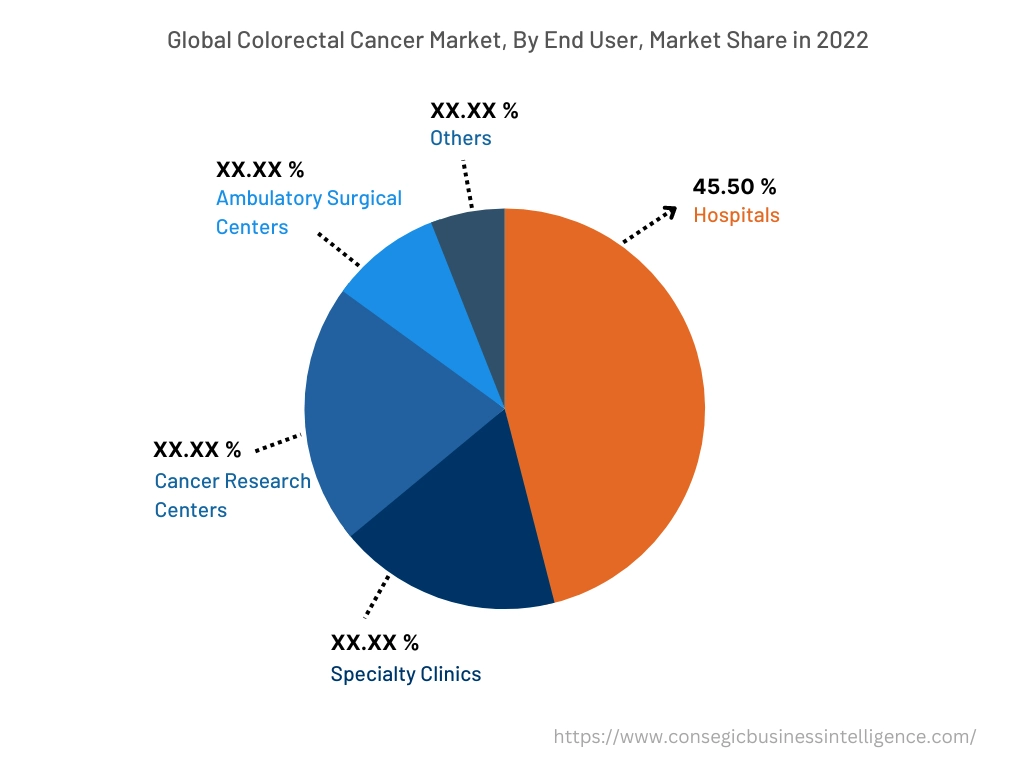
By Region :
The regional segment includes North America, Europe, Asia Pacific, the Middle East and Africa, and Latin America.
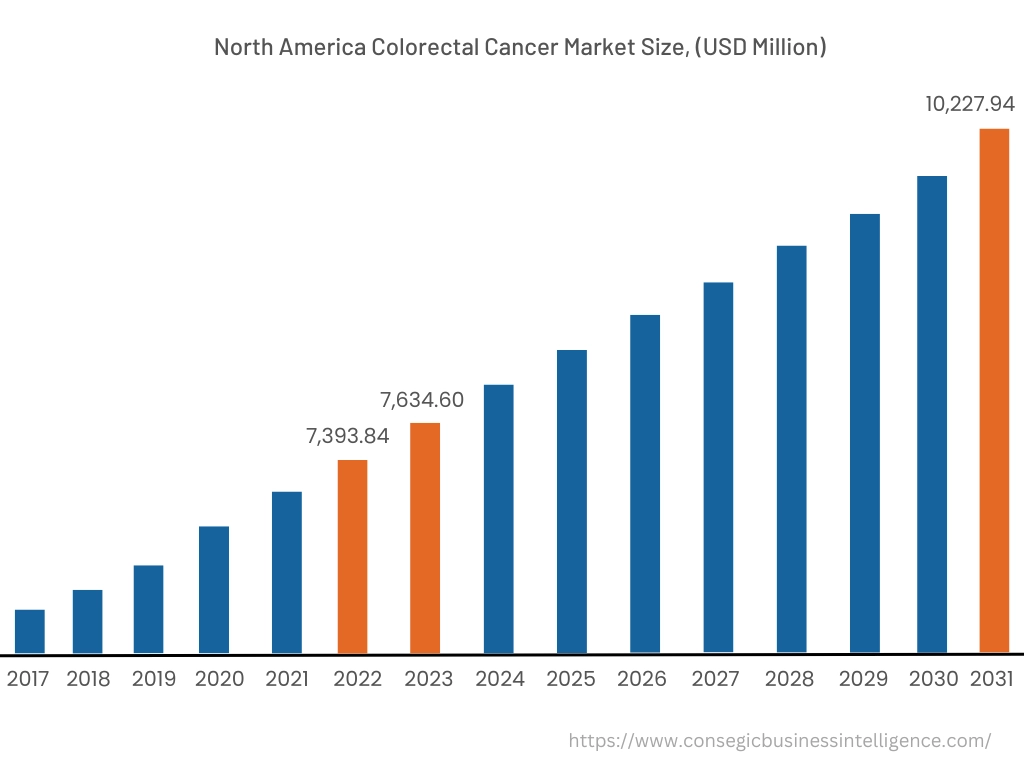
In 2022, North America accounted for the highest market share at 39.03% valued at USD 7,393.84 Million in 2022 and USD 7,634.60 Million in 2023 and is expected to reach USD 10,227.94 Million in 2031. In North America, the U.S. accounted for the highest market share of 65.10% during the base year of 2022. North America is witnessing high growth in cancer therapeutics due to increasing spending in R&D for better drugs and treatment for the cancer. For instance, according to the American Cancer Society, CRC is the third most common diagnosed cancer in the U.S. and the estimates for cancer in 2023 are 106,970 new cases of colon cancer and 46,050 new cases of rectal cancer. The colorectal cancer market analysis concluded that the increase in the number of cancer cases is promoting the need for the development of better drugs and treatment options.
Furthermore, Asia Pacific is expected to witness the fastest CAGR of 4.4% over the forecast period. The prevalence of cancer patients in Asia Pacific is increasing steadily and putting a heavy burden on healthcare systems. Furthermore, doctors are encouraging regular screening for people aged above 45 for early detection and treatment. Hence, the rise in screening for cancer has resulted in more patients being detected early and starting treatment. According to research published by the National Library of Medicine in 2021, the healthcare expenditure for treatment of cancer patients increased by 213·7% from 2009 to 2015. Analysis of market trends concludes that the high prevalence of colorectal cancer patients in Asia Pacific is promoting more R&D spending for the development of better therapeutics. As a result, the aforementioned factors are likely to bolster the market expansion during the forecast period.
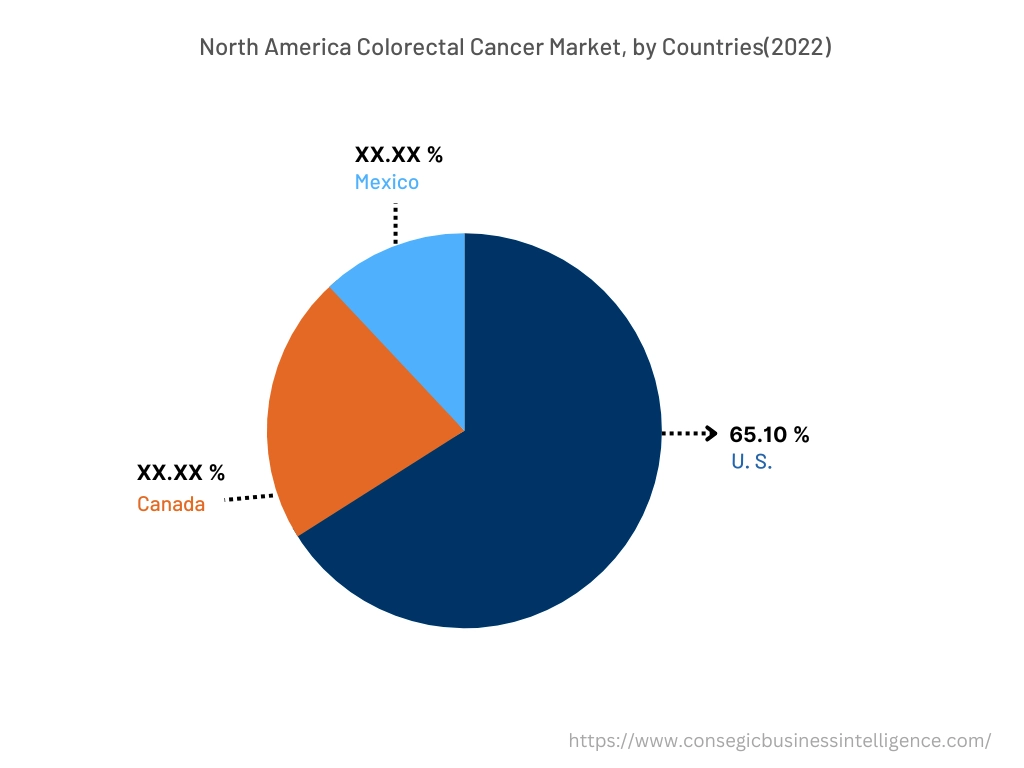
Top Key Players & Market Share Insights:
The colorectal cancer market is highly competitive, with several large players and numerous small and medium-sized enterprises. The major companies operating in the colorectal cancer industry have strong research and development capabilities and a strong presence in the market through their extensive product portfolios and distribution networks. The market is characterized by intense competition, with companies focusing on expanding their product offerings and increasing their market share through mergers, acquisitions, and partnerships. The key players in the market include-
- Genentech USA, Inc.
- Merck & Co., Inc
- Eli Lilly and Company
- TAIHO ONCOLOGY, INC.
- GSK
Recent Industry Developments :
- In April 2023, Pfizer Inc. announced that the U.S. Food and Drug Administration (FDA) has approved the use of BRAFTOVI in combination with cetuximab, for the treatment of adult patients with metastatic colorectal cancer.
- In June 2020, Merck announced that the U.S. Food and Drug Administration (FDA) has approved KEYTRUDA, Merck's anti-PD-1 therapy, as monotherapy for the first-line treatment of patients with mismatch repair deficient (dMMR) colorectal cancer.
Key Questions Answered in the Report
What was the market size of the colorectal cancer market in 2022? +
In 2022, the market size of colorectal cancer was USD 18,944.00 million
What will be the potential market valuation for the colorectal cancer market by 2031? +
In 2031, the market size of colorectal cancer is expected to reach USD 26,111.69 million.
What are the key factors driving the growth of the colorectal cancer market? +
The rising awareness of colorectal cancer is fostering market growth.
What is the dominating segment in the colorectal cancer market by type? +
In 2022, the adenocarcinoma segment accounted for the highest market share in the overall colorectal cancer market.
Based on current market trends and future predictions, which geographical region will have the fastest impact on the colorectal cancer market's growth in the coming years? +
Asia Pacific is expected to be the fastest-growing region in the market during the forecast period.
